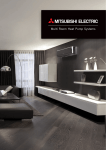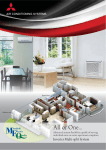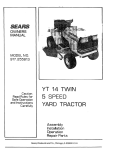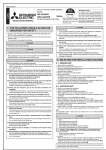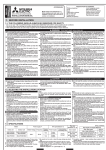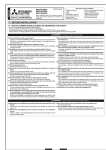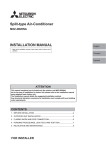Download Mitsubishi MSZ-EF35VAS Installation manual
Transcript
ENGLISH JG79R296H01 Model names are indicated in 1-3. This installation manual describes only for the indoor unit. Refer to the MXZ type manual for outdoor unit set up. SPLIT-TYPE AIR CONDITIONERS INSTALLATION MANUAL Required Tools for Installation Phillips screwdriver 4 mm hexagonal wrench Level Flare tool for R410A Scale Gauge manifold for R410A Utility knife or scissors Vacuum pump for R410A 65 mm hole saw Charge hose for R410A Torque wrench Pipe cutter with reamer Wrench (or spanner) 1. BEFORE INSTALLATION 1-1. THE FOLLOWING SHOULD ALWAYS BE OBSERVED FOR SAFETY • Be sure to read “THE FOLLOWING SHOULD ALWAYS BE OBSERVED FOR SAFETY” before installing the air conditioner. • Be sure to observe the warnings and cautions specified here as they include important items related to safety. • After reading this manual, be sure to keep it together with the OPERATING INSTRUCTIONS for future reference. WARNING (Could lead to death, serious injury, etc.) N Do not install the unit by yourself (user). Incomplete installation could cause fire or electric shock, injury due to the unit falling, or leakage of water. Consult the dealer from whom you purchased the unit or a qualified installer. N Perform the installation securely referring to the installation manual. Incomplete installation could cause fire, electric shock, or injury due to the unit falling, or leakage of water. N When installing the unit, use appropriate protective equipment and tools for safety. Failure to do so could cause injury. N Install the unit securely in a place which can bear the weight of the unit. If the installation location cannot bear the weight of the unit, the unit could fall causing injury. N Electrical work should be performed by a qualified, experienced electrician, according to the installation manual. Be sure to use an exclusive circuit. Do not connect other electrical appliances to the circuit. If the capacity of the power circuit is insufficient or there is incomplete electrical work, it could result in a fire or an electric shock. N Earth the unit correctly. Do not connect the earth to a gas pipe, water pipe, lightning rod or telephone earth. Defective earthing could cause electric shock. N Do not damage the wires by applying excessive pressure with parts or screws. Damaged wires could cause fire or electric shock. N Be sure to cut off the main power in case of setting up the indoor P.C. board or wiring works. Failure to do so could cause electric shock. N Use the specified wires to connect the indoor and outdoor units securely and attach the wires firmly to the terminal block connecting sections so the stress of the wires is not applied to the sections. Do not extend the wires, or use intermediate connection. Incomplete connecting and securing could cause fire. N Do not install the unit in a place where inflammable gas may leak. If gas leaks and accumulates in the area around the unit, it could cause an explosion. N Do not use intermediate connection of the power cord or the extension cord and do not connect many devices to one AC outlet. It could cause a fire or an electric shock due to defective contact, defective insulation, exceeding the permissible current, etc. N Be sure to use the parts provided or specified parts for the installation work. The use of defective parts could cause an injury or leakage of water due to a fire, an electric shock, the unit falling, etc. N When plugging the power supply plug into the outlet, make sure that there is no dust, clogging, or loose parts in both the outlet and the plug. Make sure that the power supply plug is pushed completely into the outlet. If there is dust, clogging, or loose parts on the power supply plug or the outlet, it could cause electric shock or fire. If loose parts are found on the power supply plug, replace it. N Attach the electrical cover to the indoor unit and the service panel to the outdoor unit securely. If the electrical cover of the indoor unit and/or the service panel of the outdoor unit are not attached securely, it could result in a fire or an electric shock due to dust, water, etc. N When installing, relocating, or servicing the unit, make sure that no substance other than the specified refrigerant (R410A) enters the refrigerant circuit. Any presence of foreign substance such as air can cause abnormal pressure rise and may result in explosion or injury. The use of any refrigerant other than that specified for the system will cause mechanical failure, system malfunction, or unit breakdown. In the worst CAUTION case, this could lead to a serious impediment to securing product safety. N Do not discharge the refrigerant into the atmosphere. If refrigerant leaks during installation, ventilate the room. If refrigerant comes in contact with a fire, harmful gas could be generated. N Check that the refrigerant gas does not leak after installation has been completed. If refrigerant gas leaks indoors, and comes into contact with the flame of a fan heater, space heater, stove, etc., harmful substances will be generated. N Use appropriate tools and piping materials for installation. The pressure of R410A is 1.6 times more than R22. Not using appropriate tools or materials and incomplete installation could cause the pipes to burst or injury. N When pumping down the refrigerant, stop the compressor before disconnecting the refrigerant pipes. If the refrigerant pipes are disconnected while the compressor is running and the stop valve is open, air could be drawn in and the pressure in the refrigeration cycle could become abnormally high. This could cause the pipes to burst or injury. N When installing the unit, securely connect the refrigerant pipes before starting the compressor. If the compressor is started before the refrigerant pipes are connected and when the stop valve is open, air could be drawn in and the pressure in the refrigeration cycle could become abnormally high. This could cause the pipes to burst or injury. N Fasten a flare nut with a torque wrench as specified in this manual. If fastened too tight, a flare nut may break after a long period and cause refrigerant leakage. N The unit shall be installed in accordance with national wiring regulations. (Could lead to serious injury in particular environments when operated incorrectly.) If there is defect in the drainage/piping work, water N Do not install the outdoor unit where small animals N Install an earth leakage breaker depending on the installation place. could drop from the unit, soaking and damaging housemay live. If an earth leakage breaker is not installed, it could hold goods. If small animals enter and touch the electric parts inside cause electric shock. the unit, it could cause a malfunction, smoke emission, N Do not touch the air inlet or the aluminum fins of the outdoor unit. or fire. Also, advise user to keep the area around the N Perform the drainage/piping work securely according to the installation manual. This could cause injury. unit clean. 1-2. SELECTING THE INSTALLATION LOCATION INDOOR UNIT Where airflow is not blocked. Where cool air spreads over the entire room. Rigid wall without vibration. Where it is not exposed to direct sunshine. Where easily drained. At a distance 1 m or more away from your TV and radio. Operation of the air conditioner may interfere with radio or TV reception. An amplifier may be required for the affected device. • In a place as far away as possible from fluorescent and incandescent lights (so the infrared remote control can operate the air conditioner normally). • Where the air filter can be removed and replaced easily. REMOTE CONTROLLER • Where it is easy to operate and easily visible. • Where children cannot touch it. • Select a position about 1.2 m above the floor and check that signals from the remote controller are surely received by the indoor unit from that position (‘beep’ or ‘beep beep’ receiving tone sounds). After that, attach remote controller holder to a pillar or wall and install wireless remote controller. • • • • • • Note: Note: In rooms where inverter type fluorescent lamps are used, It is advisable to make a piping loop near outdoor unit so as the signal from the wireless remote controller may not be to reduce vibration transmitted from there. received. Note: OUTDOOR UNIT When operating the air conditioner in low outside tempera• Where it is not exposed to strong wind. ture, be sure to follow the instructions described below. • Where airflow is good and dustless. • Where rain or direct sunlight can be avoided as much as • Never install the outdoor unit in a place where its air inlet/outlet side may be exposed directly to wind. possible. • Where neighbours are not annoyed by operation sound • To prevent exposure to wind, install the outdoor unit with its air inlet side facing the wall. or hot air. • Where rigid wall or support is available to prevent the • To prevent exposure to wind, it is recommended to install a baffle board on the air outlet side of the outdoor increase of operation sound or vibration. unit. • Where there is no risk of combustible gas leakage. Avoid the following places for installation where air condi• When installing the unit at a high level, be sure to secure tioner trouble is liable to occur. the unit legs. • Where it is at least 3 m away from the antenna of TV set • Where flammable gas could leak. or radio. Operation of the air conditioner may interfere with • Where there is much machine oil. radio or TV reception in areas where reception is weak. • Salty places such as the seaside. • Where sulfide gas is generated such as a hot spring. An amplifier may be required for the affected device. • Where there is high-frequency or wireless equipment. • Install the unit horizontally. • Please install it in an area not affected by snowfall or • Where there is emission of high levels of VOCs, including phthalate compounds, formaldehyde, etc., which blowing snow. In areas with heavy snow, please install a may cause chemical cracking. canopy, a pedestal and/or some baffle boards. 1-3. SPECIFICATIONS Model Indoor unit MSZ-EF22VA(W/B/S) MSZ-EF25VA(W/B/S) MSZ-EF35VA(W/B/S) MSZ-EF42VA(W/B/S) MSZ-EF50VA(W/B/S) Power supply *1 Outdoor unit – Rated Voltage 230 V *7 Frequency 50 Hz Wire specifications *2 Breaker capacity – *7 Power supply Indoor/outdoor connecting wire – 4-core 1.0 mm2 *7 Pipe size (thickness *3, *4) Gas / Liquid ø9.52 / 6.35 mm (0.8 mm) ø12.7 / 6.35 mm (0.8 mm) *1 Connect to the power switch which has a gap of 3 mm or *5 Be careful not to crush or bend the pipe during pipe bending. *8 Insulation material : Heat resisting foam plastic 0.045 more when open to interrupt the source power phase. (When *6 Refrigerant pipe bending radius must be 100 mm or more. specific gravity *7 Refer to the installation manual of the multi-type outdoor *9 Be sure to use the insulation of specified thickness. Excesthe power switch is shut off, it must interrupt all phases.) *2 Use wires in conformity with design 60245 IEC 57. sive thickness may cause incorrect installation of the indoor units. *3 Never use pipes with thickness less than specified. The unit and insufficient thickness may cause dew drippage. pressure resistance will be insufficient. *4 Use a copper pipe or a copper-alloy seamless pipe. 1-4. INSTALLATION DIAGRAM (1) Installation plate (2) 1 Installation plate fixing screw 4 × 25 mm 5 (3) Remote controller holder (4) Be sure to use wall hole sleeve (C) to prevent in- Indoor unit door/outdoor connecting wire (A) from contacting Wall hole metal parts in the wall and sleeve (C) to prevent damage by rodents in case the wall is hollow. 107.5 or momm re Fixing screw for (3) 3.5 × 16 mm (Black) Fix the pipe to wall with pipe fixing band (E). or mo Pipe fixing band (E) Fixing screw (F) 2 Felt tape (For left or left-rear piping) 1 (8) Soft dry cloth (VAB type only) 1 After the leak test, apply insulating material tightly so that there is no gap. When the piping is to be attached to a wall containing metals (tin plated) or metal netting, use a chemically treated wooden piece 20 mm or thicker between the wall and the piping or wrap 7 to 8 turns of insulation vinyl tape around the piping. To use existing piping, perform COOL operation for 30 minutes and pump down before removing the old air conditioner. Remake flare according to the dimension for new refrigerant. 7 mm or more PARTS TO BE PROVIDED AT YOUR SITE Indoor/outdoor unit connecting wire* 1 Extension pipe 1 Wall hole sleeve 1 Wall hole cover 1 Pipe fixing band 2 to 5 Fixing screw for (E) 4 × 20 mm 2 to 5 Piping tape 1 Putty 1 Drain hose (I) (or soft PVC hose, 15 mm inner diameter or hard PVC pipe VP16) Seal the wall hole gap with putty (H). re 2 1 (A) (B) (C) (D) (E) (F) (G) (H) Wall hole cover (D) Cut off the extra length. 117.5 mm 1 (5) Battery (AAA) for (6) (6) Wireless remote controller (7) 72 mm or more/ 128 mm or more for left and left back piping (using spacer) ACCESSORIES Check the following parts before installation. <Indoor unit> 1 or 2 (J) Refrigeration oil (K) Power supply cord* 1 1 * Note: Place indoor/outdoor unit connecting wire (A) and power supply cord (K) at least 1 m away from the TV antenna wire. IMPORTANT NOTES To comply with the requirements of Australian standard AS/NZS 3000 electrical installations (wiring rules), the electrical wiring required between the indoor and outdoor units must be installed by a licenced electrical contractor. Units should be installed by licensed contractor according to local code requirements. 2. INDOOR UNIT INSTALLATION CAUTION Protective film covers the front panel of some indoor units. When installing those indoor units, leave the film on it to prevent scratching until installation completes. 2-1. FIXING OF INSTALLATION PLATE • Find a structural material (such as a stud) in the wall and fix installation plate (1) horizontally with fixing screws (2). • To prevent installation plate (1) from vibrating, be sure to install the fixing screws in the holes indicated in the illustration. For added support, fixing screws may also be installed in other holes. • When the knockout is removed, apply vinyl tape to the knockout edges to prevent damaging the wires. • When bolts recessed in the concrete wall are to be utilized, secure installation plate (1) using 11 × 20 · 11 × 26 oval hole (450 mm pitch). • If the recessed bolt is too long, change it for a shorter one available in the market. 2-2. WALL HOLE DRILLING Ceiling 5-7 mm Outdoor side 72 mm or more 128 mm or more for left and left Level 107.5 mm or more 117.5 mm or more 100 mm Wall Fixing screw (2) Insert the scale. * VA clamp Fixing screw 35 mm back piping (using spacer) Installation plate (1) Terminal block 15 mm Wall 1) Determine the wall hole position. 2) Drill a ø65 mm hole. The outdoor side should be ø65 mm 5 to 7 mm lower than the indoor side. 3) Insert wall hole sleeve (C). 3) Pass indoor/outdoor unit connecting wire (A) from the back of the indoor unit and process the end of the wire. 4) Loosen terminal screw, and connect first the earth wire, then indoor/outdoor unit connecting wire (A) to the terminal block. Be careful not to make mis-wiring. Fix the wire to the terminal block securely so that no part of its core is appeared, and no external force is conveyed to the connecting section of the terminal block. 5) Firmly tighten the terminal screws to prevent them from loosening. After tightening, pull the wires lightly to confirm that they do not move. 6) Secure indoor/outdoor unit connecting wire (A) and the earth wire with the VA clamp. Never fail to hook the left claw of the VA clamp. Attach the VA clamp securely. Align the scale with the line. * Wall Center of ø65 mm hole * Same for left hole. 2-3. CONNECTING WIRES FOR INDOOR UNIT You can connect indoor/outdoor lead wire without removing the front panel. 1) Open the front panel. 2) Remove VA clamp. Lead wire • For future servicing, give extra length to the connecting wires. • Make earth wire a little longer than others. (More than 60 mm) • Do not fold the excess wire, or cram it into small space. Take caution not to damage the wires. • Be sure to attach each screw to its correspondent terminal when securing the cord and/or the wire to the terminal block. Note: Do not place the wires between the indoor unit and the installation plate (1). Damaged wire could cause heat generation or fire. Indoor/outdoor unit connecting wire (A) Indoor terminal block Earth wire (green/yellow) Indoor/outdoor unit connecting wire (A) 2-4. PIPE FORMING AND DRAIN PIPING Pipe Forming • Place the drain hose below the refrigerant piping. • Make sure that the drain hose is not heaved or snaked. • Do not pull the hose when applying the tape. • When the drain hose passes the room, be sure to wrap insulation material (obtainable at a store) around it. Outdoor terminal block Liquid pipe Gas pipe Indoor/outdoor unit connecting wire (A) Felt tape (7) Piping tape (G) Rear, right, or downward piping Cut off in case of 1) Put the refrigerant piping and the drain hose right piping. together, then firmly apply piping tape (G) from the end. Cut off in case of 2) Insert the piping and the drain hose into the downward piping. wall hole sleeve (C), and hook the upper part of the indoor unit on the installation plate (1). 3) Check if the indoor unit is hooked securely on the installation plate (1) by moving the unit to left and right. 4) Thrust the lower part of the indoor unit into the installation plate (1). Drain Piping • If the extension drain hose has to pass through a room, be sure to wrap it with commercially sold insulation. • The drain hose should point downward for easy drain flow. (Fig. 1) • If the drain hose provided with the indoor unit is too short, connect it with drain hose (I) that should be provided at your site. (Fig. 2) • When connecting the drain hose to the hard vinyl chloride pipe, be sure to insert it securely into the pipe. (Fig. 3) Drain hose Drain hose Downward slope Hard vinyl chloride pipe I.D. 30 mm 70 cm or more Soft hose I.D. 15 mm Insert securely Different diameter joint Fig. 1 Fig. 2 Fig. 3 Do not make drain piping as shown below. Accumulated drain water Do not raise Tip of drain hose dipped in water Air Water leakage Water leakage Water leakage Waving At least 50 mm gap Ditch Left or left-rear piping Note: Be sure to reattach the drain hose and the drain cap in case of left or left-rear piping. Otherwise, it could cause drops of water to drip down from the drain hose. Piping tape (G) Felt tape (7) 1) Put the refrigerant piping and the drain hose together, then firmly apply felt tape (7) from the end. Felt tape (7) overlap width should be 1/3 the tape width. Use a bandage stopper at the end of felt tape (7). 2) Pull out the drain cap at the rear right of the indoor unit. (Fig. 1) • Hold the convex section at the end and pull the drain cap. 3) Pull out the drain hose at the rear left of the indoor unit. (Fig. 2) • Hold the claw marked by the arrows and pull out the drain hose forward. 4) Put the drain cap into the section to which the drain hose is to be attached at the rear of the indoor unit. (Fig. 3) • Insert not sharp-edged tools such as screwdrivers into the hole at the end of the cap and insert the cap fully into the drain pan. 5) Insert the drain hose fully into the drain pan at the rear right of the indoor unit. (Fig. 4) • Check if the hose is hooked securely to the projection of its inserting part at the drain pan. 6) Insert the drain hose into wall hole sleeve (C), and hook the upper part of indoor unit on installation plate (1). Then, move the indoor unit completely to the left in order to make placing the piping in the back space of the unit easier. 7) Cut out a piece of cardboard from the shipping box, roll it up, hook it onto the back rib, and use it as a spacer to lift the indoor unit. (Fig. 5) 8) Connect the refrigerant piping with the extension pipe (B). 9) Thrust the lower part of the indoor unit into the installation plate (1). Cut off in case of left piping. Drain cap Drain cap Fig. 1 Drain hose Fig. 2 Drain cap Fig. 3 Drain hose Fig. 4 Fig. 5 2-5. FLARING WORK 2-6. PIPE CONNECTION 1) Cut the copper pipe correctly with pipe cutter. Copper (Fig. 1, 2) pipe 2) Completely remove all burrs from the cut cross section of pipe. (Fig. 3) Fig. 1 • Put the end of the copper pipe to downward direction as you remove burrs in order to avoid to let burrs drop in the piping. No good Good 3) Remove flare nuts attached to indoor and outdoor units, then put them on pipe having completed burr removal. (Not possible to put them on after flaring work.) 4) Flaring work (Fig. 4, 5). Firmly hold copper pipe in the Tilted Uneven Burred dimension shown in the table. Select A mm from the Fig. 2 table according to the tool you use. 5) Check • Compare the flared work with Fig. 6. • If flare is noted to be defective, cut off the flared section and do flaring work again. Flaring tool • Fasten flare nut with a torque wrench as specified in the table. • When fastened too tight, flare nut may break after a long period and cause refrigerant leakage. • Be sure to wrap insulation around the piping. Direct contact with the bare piping may result in burns or frostbite. Burr Copper pipe Clutch type Fig. 3 Wing nut type Fig. 4 Smooth all around Inside is shining without any scratches. Copper pipe Die Pipe diameter (mm) ø 6.35 (1/4”) ø 9.52 (3/8”) ø12.7 (1/2”) ø15.88 (5/8”) Fig. 5 Outdoor unit connection Connect pipes to stop valve pipe joint of the outdoor unit in the same manner applied for indoor unit. • For tightening, use a torque wrench or spanner and use the same tightening torque applied for indoor unit. WARNING When installing the unit, securely connect the refrigerant pipes before starting the compressor. Spare reamer Pipe cutter Flare nut Indoor unit connection Connect both liquid and gas pipings to indoor unit. • Apply a thin coat of refrigeration oil (J) on the seat surface of pipe. • For connection, first align the center, then tighten the first 3 to 4 turns of flare nut. • Use tightening torque table above as a guideline for indoor unit side union joint section, and tighten using two wrenches. Excessive tightening damages the flare section. Even length all around A (mm) Nut Clutch type Clutch type (mm) tool tool for R410A for R22 17 22 0 to 0.5 1.0 to 1.5 26 29 Fig. 6 Tightening torque Wing nut type tool for R22 N•m 13.7 to 17.7 34.3 to 41.2 49.0 to 56.4 2.0 to 2.5 73.5 to 78.4 1.5 to 2.0 kgf•cm 140 to 180 350 to 420 500 to 575 750 to 800 2-7. INSULATION AND TAPING 1) Cover piping joints with pipe cover. 2) For outdoor unit side, surely insulate every piping including valves. 3) Using piping tape (G), apply taping starting from the entry of outdoor unit. • Stop the end of piping tape (G) with tape (with adhesive agent attached). • When piping have to be arranged through above ceiling, closet or where the temperature and humidity are high, wind additional commercially sold insulation to prevent condensation. 3. PURGING PROCEDURES, LEAK TEST, AND TEST RUN 3-1. PURGING PROCEDURES AND LEAK TEST 3-3. AUTO RESTART FUNCTION Refer to the procedures indicated in the installation manual of the outdoor unit. This product is equipped with an auto restart function. When the power supply is stopped during operation, such as during blackouts, the function automatically starts operation in the previous setting once the power supply is resumed. (Refer to the operating instructions for details.) 3-2. TEST RUN 1) Insert power supply plug into the power outlet and/or turn on the breaker. 2) Press the E.O. SW once for COOL, and twice for HEAT operation. Test run will be performed for 30 minutes. If the left lamp of the operation indicator blinks every 0.5 seconds, inspect the indoor/outdoor unit connecting wire (A) for miswiring. After the test run, emergency mode (set temperature 24°C) will start. 3) To stop operation, press the E.O. SW several times until all LED lamps turn off. Refer to operating instructions for details. Emergency operation switch (E.O. SW) Checking the remote (infrared) signal reception Press the ON/OFF button on the remote controller (6) and check that an electronic sound is heard from the indoor unit. Press the ON/OFF button again to turn the air conditioner off. • Once the compressor stops, the restart preventive device operates so the compressor will not operate for 3 minutes to protect the air conditioner. Caution: • After test run or remote signal reception check, turn off the unit with the E.O. SW or the remote controller before turning off the power supply. Not doing so will cause the unit to start operation automatically when power supply is resumed. To the user • After installing the unit, make sure to explain the user about auto restart function. • If auto restart function is unnecessary, it can be deactivated. Consult the service representative to deactivate the function. Refer to the service manual for details. 3-4. EXPLANATION TO THE USER • Using the OPERATING INSTRUCTIONS, explain to the user how to use the air conditioner (how to use the remote controller, how to remove the air filters, how to remove or put the remote controller in the remote controller holder, how to clean, precautions for operation, etc.). • Recommend the user to read the OPERATING INSTRUCTIONS carefully. 4. RELOCATION AND MAINTENANCE 4-1. REMOVING AND INSTALLING THE PANEL ASSEMBLY Removal procedure 1) Unlock the upper and lower vanes as and using a thin instrument. shown in Then, remove the horizontal vanes. 2) Remove the 2 screws which fix the panel assembly. 3) Remove the panel assembly. Be sure to remove its bottom right end first. Unlock Upper and lower vanes 3 3 3 Installation procedure 1) Install the panel assembly following the removal procedure in reverse. 2) Be sure to press the positions as indicated by the arrows in order to attach the assembly completely to the unit. 3) Install the horizontal vanes. 4-3. PUMPING DOWN When relocating or disposing of the air conditioner, pump down the system following the procedure below so that no refrigerant is released into the atmosphere. 1) Connect the gauge manifold valve to the service port of the stop valve on the gas pipe side of the outdoor unit. 2) Fully close the stop valve on the liquid pipe side of the outdoor unit. 3) Close the stop valve on the gas pipe side of the outdoor unit almost completely so that it can be easily closed fully when the pressure gauge shows 0 MPa [Gauge] (0 kgf/ cm2). 4) Start the emergency COOL operation. To start the emergency operation in COOL mode, disconnect the power supply plug and/or turn off the breaker. After 15 seconds, connect the power supply plug and/or turn on the breaker, and then press the E.O. SW once. (The emergency COOL operation can be performed continuously for up to 30 minutes.) 5) Fully close the stop valve on the gas pipe side of the outdoor unit when the pressure gauge shows 0.05 to 0 MPa [Gauge] (approx. 0.5 to 0 kgf/cm2). 6) Stop the emergency COOL operation. Press the E.O. SW several times until all LED lamps turn off. Refer to operating instructions for details. WARNING When pumping down the refrigerant, stop the compressor before disconnecting the refrigerant pipes. The compressor may burst if air etc. get into it. 4-2. REMOVING THE INDOOR UNIT Remove the bottom of the indoor unit from the installation plate. When releasing the corner part, release both left and right bottom corner part of indoor unit and pull it downward and forward as shown in the figure on the right. HEAD OFFICE: TOKYO BLDG., 2-7-3, MARUNOUCHI, CHIYODA-KU, TOKYO 100-8310, JAPAN




